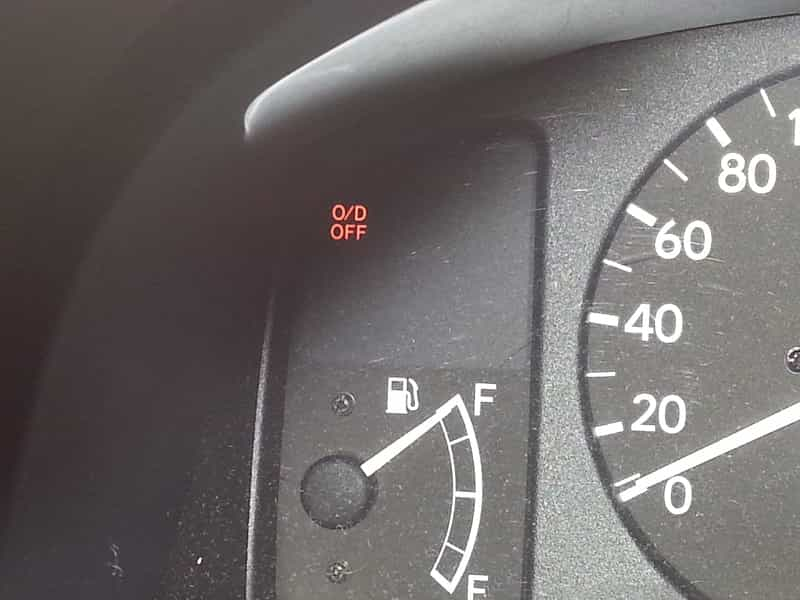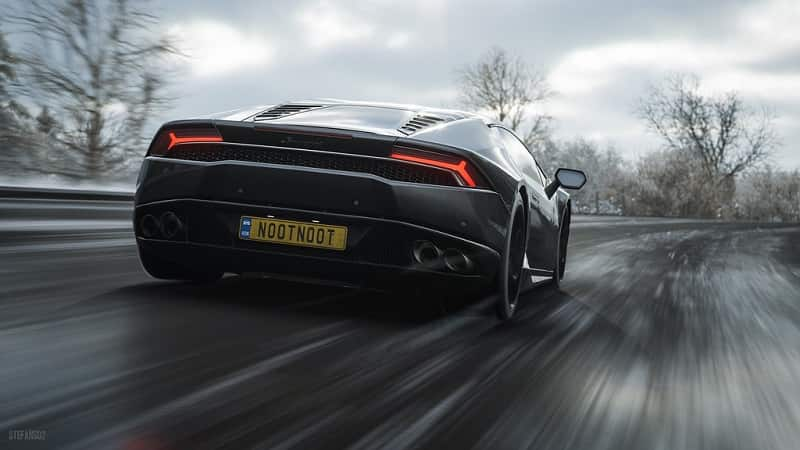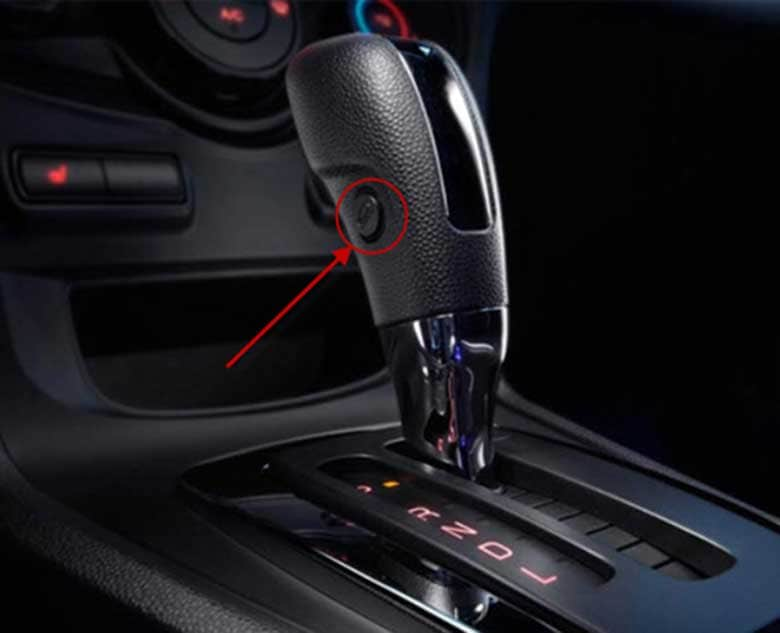In my two-decade experience as an expert in the automotive field, I’ve come to try many technologies aiming to improve the driving experience.
However, perhaps the most confusing is the overdrive function on some older vehicles with automatic transmissions, presented by a button near the gear lever. Even more puzzling is the O/D (for overdrive) off light on the instrument panel, which drivers often don’t understand what it does.
But I’ll put all those ambiguities to the rest today and, once and for all, explain what overdrive is and why modern cars don’t have the function anymore. Moreover, I’ll tell you when you need to engage the overdrive function and when you need to keep the O/D feature off.

O/D Off Meaning
Contents
What is Overdrive?
Although most people I know think the O/D function gives the vehicle extra power, the opposite is actually true. The word “overdrive” doesn’t come from driving over the capabilities of the car – it comes from drive ratios.
And, in mechanics, a transmission ratio that’s less than 1:1, i.e., a ratio that multiplies the engine speed rather than reducing it. In other words, any gear in your transmission that’s lower than the direct 1:1 ratio is considered overdrive.
1. Overdrive in modern vehicles
So, in a six-speed gearbox vehicle, in most cases, the 4th gear is the one with the direct ratio, while the 5th and 6th gears are considered overdrive. As a result, these gears push the engine to lower rpm, which has a positive effect on fuel economy and comfort on the highway.
Important disclaimer: when talking about the overall transmission ratio on any car, it’s important to note that every transmission has a final ratio. Thus, when you calculate the overall engine-to-wheel ratio, you also need to take that into account.
2. First cars with O/D
Okay, so why did older vehicles have an overdrive function? And how did it work in the past? Well, the first cars with an O/D function had a three-speed or a four-speed automatic transmission, where the highest gear was a direct drive (1:1).
This made the highest gears great for achieving top speed but not for fuel economy, as the engine was kept at very high rpms. Not to mention, a direct drive ratio strained the engine and shortened its lifespan if you drove your vehicle mostly on the highway, and let’s not forget about the noise.
To alleviate all those issues, automakers started putting an overdrive function in most vehicles in the 60s. The first such system actually changed the final ratio by employing another tiny gearbox connected to the main one.
Hence, after engaging the feature, it changed the ratio of all gears – not just the final third or fourth gear. As such, it was helpful on the highway, sure, but it significantly reduced the torque in all other gears and thus hampered acceleration.
In other words, you were only supposed to engage O/D when driving on the highway and disengage when driving in urban scenarios, on a steep incline, towing, or just overtaking.
3. Implementing the O/D feature into the main gearbox
To simplify things and allow front-wheel-drive vehicles to have overdrive gear, automakers started implementing the function into the gearbox itself. How did they do that? Well, by simply adding more overdrive gears; for example, a five-speed automatic or manual transmission has one O/D gear.
But since the gearbox already had overdrive built in, why was the lever/button inside the cabin still necessary? The problem was – gearboxes weren’t smart enough back then and hunted through gears when presented with higher load and/or speed.
Thus, automakers still left the driver with the decision to engage the feature depending on the circumstances. To help the driver, every car with an automatic transmission had an O/D off light on the dashboard, which told the driver when the overdrive feature was not engaged.
Put differently, with the O/D off light illuminated, your vehicle wouldn’t shift into overdrive gear and only shift to the direct drive gear (usually 4th). Why manufacturers didn’t put an O/D on light is beyond me, but that was the way things were back then.
Not that you understood what the O/D off light means, let’s see when and where you’ll need the overdrive feature engaged or disengaged.
How to Understand and Use the O/D Off Light Effectively?
1. Driving on the Highway

Used O/D on highway
The main purpose of the overdrive function is to make your vehicle more efficient and quieter on the highway. Hence, whenever you drive at higher speeds – north of 50 mph, I recommend engaging the feature.
2. Driving in Urban Scenarios
Although it seems counterintuitive, I’d still suggest engaging overdrive in urban scenarios (O/D off light not illuminated), but only on cars with five or more gears.
By doing this, you enable the transmission to shift into the highest gear, which helps with fuel economy. If you needed sudden acceleration, you always had the kick-down function; just press hard on the acceleration pedal, and the transmission would shift into a lower gear.
However, on some very old cars with an overdrive feature that’s separated from the main gearbox, I’d suggest turning the feature off because it would change the ratios of every gear and limit acceleration.
3. Driving on Hilly and Twisty Roads
Old automatic transmissions had serious issues with hunting, i.e., constantly shifting between a higher and lower gear to find the optimal ratio when presented with a higher load.
This was especially true on hilly roads. For instance, if you had the overdrive function engaged (O/D off light not illuminated), the transmission would shift into the highest gear on steep inclines. Then, the engine would’ve faced more load and started losing revolutions, which would’ve engaged a lower gear, and repeated the process.
By simply disengaging the feature (O/D off light illuminated), you’d limit the transmission to the direct ratio gear, which would significantly reduce gear hunting.
Driving downhill is also unsafe with the overdrive feature on, as the transmission would’ve shifted into the highest gear, limiting engine braking. In this case, you’ll also want the O/D off light illuminated on your dashboard.
I’d also disengage overdrive on twisty roads, as vehicles are more stable when engaged in lower gears and also for overtaking.
Some older vehicles also had additional “2” and “3” functions on the shift lever. These limited the gearbox to shifting only up to the second or third gear, which was tremendously helpful on very steep inclines/declines.
4. Towing a Trailer
Towing a trailer with the overdrive feature can be dangerous on hilly or twisty roads, as you’d want as much power and engine braking as you can get in those circumstances.
However, you could engage the feature on the highway if your engine has enough torque to cope with the added weight.
Do Modern Cars Still Have Overdrive Functions?

O/D button on a new car model
Modern vehicles have overdrive gears and, in some cases, up to five (10-speed automatic transmissions)! However, you’ll see that the overdrive feature (button or lever) or the O/D off light is missing in the latest cars, and that’s largely thanks to smarter ECUs (Electronic Control Units).
These “car computers” draw information from various sensors around the vehicle, measuring speed, load, G-forces, yaw/pitch, etc. Basically, the ECU knows almost everything about the car at that moment, including whether you drive on an incline or tow a heavy trailer.
Then, the ECU uses the data to tell the transmission what’s the optimal gear ratio at that particular time and mostly nails it. As a result, modern cars hunt much less for gears and will never leave you without power or engine braking.
Still, they are not perfect, which is why most modern automatic gearboxes have a manual function. Thanks to that feature, drivers can choose any particular gear at any given time just by pushing the lever slightly or using paddles behind the steering wheel – just like in Formula One!
What is Overdrive in a Manual Transmission Car?
Any gear higher than the direct drive is considered overdrive, even in manual transmissions. Today, six-speed manual transmissions are the norm, where the 5th and 6th gear are considered overdrive, and the 4th gear is direct drive. In these cars, it’s entirely up to the drivers which gear they use.
Do CVTs Have Overdrive?
CVTs don’t have an overdrive function, i.e., no O/D off light on the dashboard. The main reason is that by nature, CVTs always keep the engine in its sweet range, i.e., when it produces the most torque while wasting the least fuel, by giving you infinite drive ratios.
Moreover, these transmissions would immediately shift into a lower gear ratio and give you maximum power (keep the engine at the highest rpm) for the best possible acceleration. As such, they seem to always be in the right gear on inclines, though the droning noise of the engine constantly being at high revolutions can certainly be tiring.
Regardless, you really shouldn’t care about the O/D off light in a CVT car at all.
This video is for detailed guides:
Video created by Ben Lau
Final Words
You can see that I exhausted this subject quite significantly, but it’s for a reason – understanding the gear ratios is hugely important for safety!
I have witnessed many situations where a friend of mine would try to overtake in a higher gear and spend too much time in the opposing lane. In some circumstances, we avoided huge crashes at the last moment.
So, whether you drive an older car with an overdrive feature, a modern automatic, or a stick shift, make sure you understand every scenario and what’s the best possible gear to use! Hope this article helped you with that!
I’m Ivo Gievski, the content writer for Tireer. We built our website with over 15 years of experience and extensive research in the automotive and technology sectors. My dedication to delivering high-quality content is unwavering, and I strive to continuously hone my skills to stay ahead of industry trends and provide readers with informative, engaging, and valuable insights.
let me know if have gotten you correctly,the od/off should appear on the dashboard when am driving locally urban roads or in situations like I keep changing gears oftenly.
Then when am in High way it should be not seen on the dashboard because am in a constant speed,is that right?